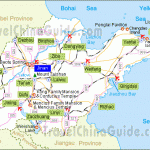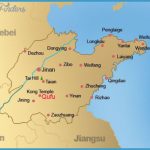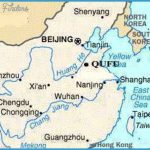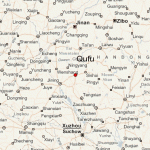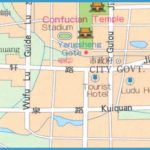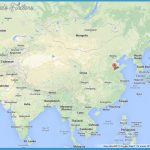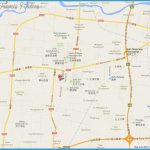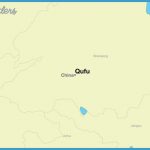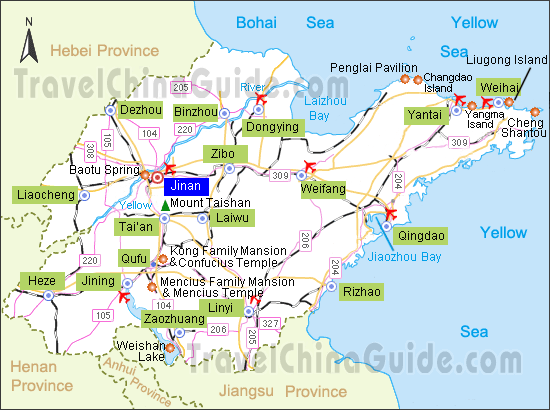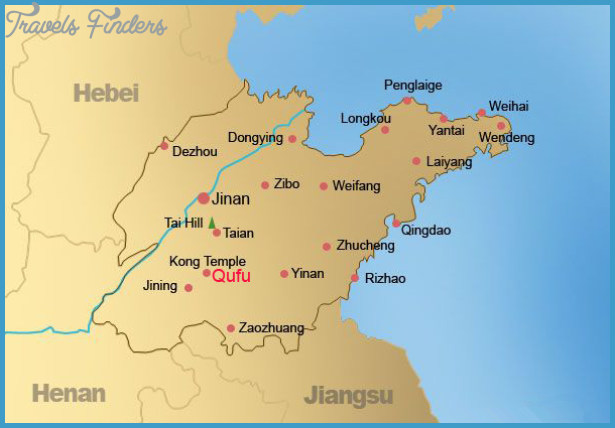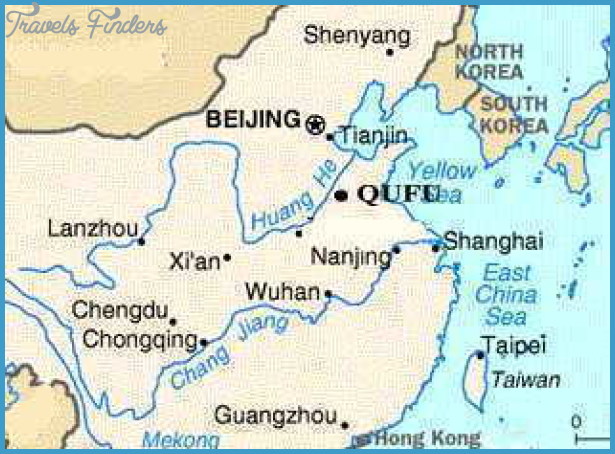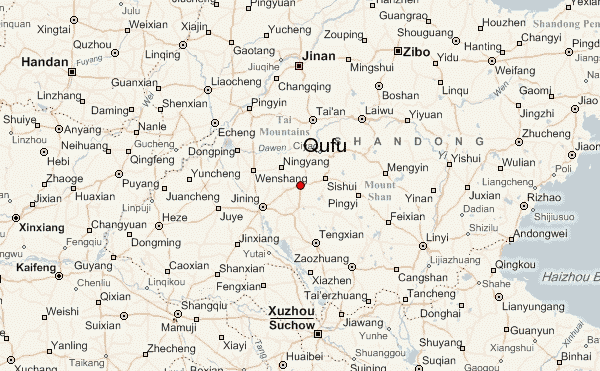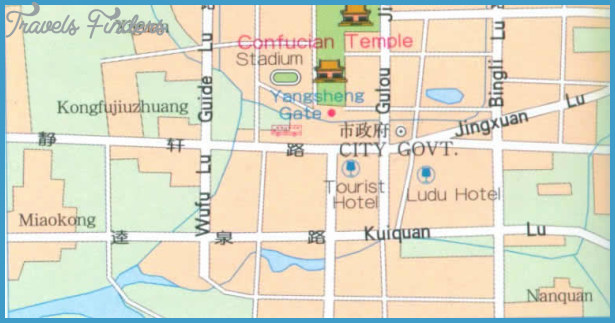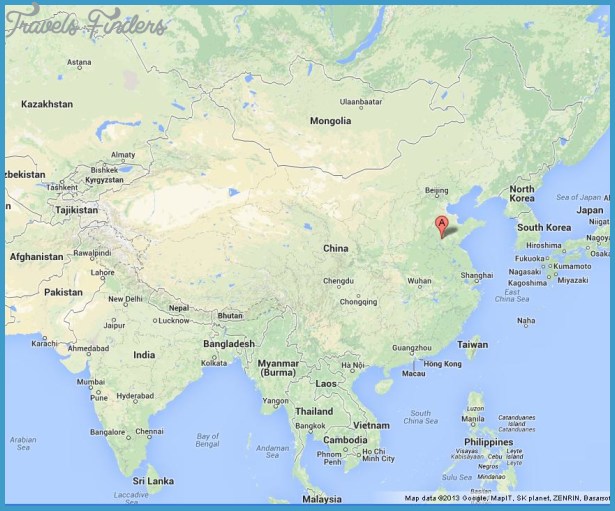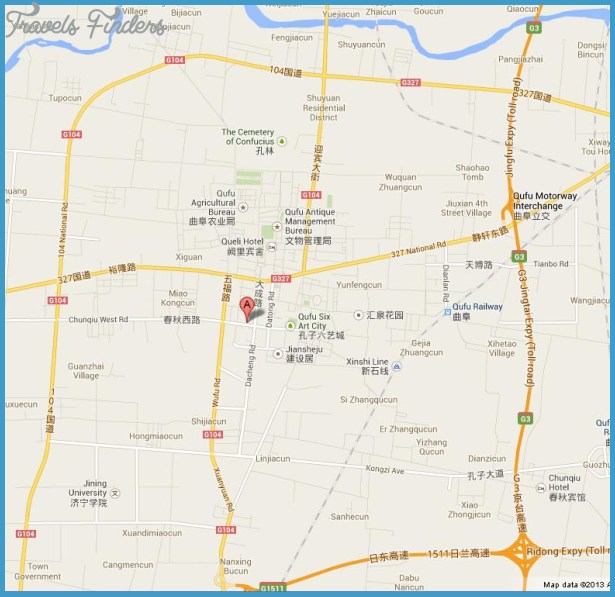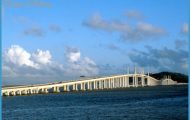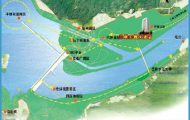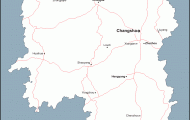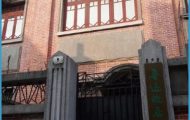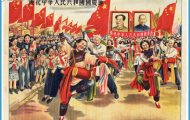Province: Shandong
Altitude: 63m/206ft. Area: 895sq.km/345sq. miles Population: 510,000
Qufu lies at 116°58’E and 35°36’N, in the south ofthe Shandong Province, some 170km/105 miles to the south ofthe provincial capital of Jinian, with which there are connections by rail and bus.
In the “spring and autumn periods” (770-476 b.c.) Qufu was the capital of the dukedom of Lu. As this is the birth place of Confucius (see Famous People), the city has remained a “mecca” for his followers.
Sights
The temple complex (22ha/54 acres) was built in 478 b.c. only one year afterthe death ofthe philosopher at the instigation of Duke Lu Aigong. The temple stands on the site of the house where Confucius was born. In the course of centuries the building has been repeatedly damaged, restored over 60 times and extended. The alterations finally ceased in the 18th c. and since then the building has remained unchanged.
The 1km/1/2 mile long and over 200m/218yd wide temple grounds, surrounded by Cyprus trees, incorporate nine courtyards lined by groups of 466 buildings of various designs. Together with the Imperial Palace in Beijing and the Imperial Summer Palace in Chengde, the temple is one of the three outstanding creations of ancient Chinese architecture.
There is a defence tower on each of the four sides ofthe red curtain wall. The main buildings are arranged along a north-south axis, with the side buildings lying symmetrically next to them.
The Star Gate forms the main entrance and leads to the first courtyard with its decorative gates ofthe Ming period (1368-1644).
The second courtyard is entered by the Gate of the Omniscient (Sengsi Men) which also dates from the Ming period; this courtyard is guarded by two stone warriors ofthe Han period (206-220 B.C.), former grave goods. They stand 2.54m/8ft to 2.30m/7ft high; one is armed with a sword, the other with a lance.
The core of the temple complex is entered through the Dazhong Men Gate.
Confucian Temple
To the north-east and north-west of this are two guest houses which once offered hospitality to the people who carried out the ceremonies held in honour of Confucius.
The Pavilion ofthe Literary Star, erected in 1018, was rebuilt in 1191 and extended in 1500. Collections of handwriting by several emperors were once housed here. The structure is an outstanding example of traditional Chinese architecture.
The next courtyard is entered by the Dacheng Men Gate where another pavilion, the so-called Apricot Altar, is situated. This was where Confucius taught his students, and a stone tablet dating from the 12th c. can be seen on the altar. In 1569 a pavilion was erected around this historically important altar. The rectangular structure housing two steles has a two-tiered roof, covered in yellow ceramic tiles.
In front of the pavilion can be seen a stone censer dating from the Song period (960-1279).
This hall is 32m/105ft high, 34m/111ft long and 54m/177ft wide. It dates from the 11thc.and isthemain building of the complex. Here were heldthe ceremonies in honour of Confucius. Throughout the centuries it has been damaged several times, and in 1724 it was completely rebuilt. The hall, which stands on a 2m/6ft high terrace, has stone columns, dragon reliefs, and a yellow ceramic tiled roof. Apart from the statue of Confucius, statues of his sixteen pupils are also housed here. All the statues are made of painted earthenware.
The Hall of Sleep, dating from 1019, is dedicated to the wife of Confucius. It was restored and extended in 1500 and completely rebuilt in 1730.
In the Hall ofthe Signs of the Wise Man (1592) are 120 engravings in stone, portraying scenes from the life of Confucius; they were engraved by famous painters and calligraphers between the 8th c. and the 13th c.
Apart from the main buildings the following monuments are of interest: Old Fountain of Confucius (Kongzhai Gujin) to the east of the Xintan, and the Red Lu Wall (Lu-Bi), where the works of Confucius were hidden when the Qin Emperor Shi Huangdi buried his followers alive and burnt all the master’s writings. The Hall of Songs and Rites (Shili Tang) is supposed to commemorate the important teachings of Confucius. In the western part of the parkisthe JinsiTang Hall whereare kept old musical instruments which were played at the ceremonies.
This is the residence of Confucius, which is the Latinised name for Kong Fuzi, the equivalent of Master Kong. Lying to the east of the Temple of Confucius, it has a total area of 16ha/39 acres. In the Han period (206-220 b.c.) the family, already titled and possessing considerable wealth, had to administer the master’s temple and supervise the rites and ceremonies. During the Ming period (1368-1644) residences were built for them next to the temple. The residential quarters, consisting of nine courtyards, numerous buildings and a garden, is divided into three sections. In the middle section are various offices, the former seat ofthe local government of Qufu and the bedchambers of the family members. The eastern section is reserved for religious ceremonies and rituals. The western section, which originally housed a library and several studies, has now been converted into a hotel.
The Yanmiao to the north of Qufu was erected in 200 b.c. for Yan Hui, the favourite pupil of Confucius. The untimely death at 32 of the extremely gifted Yan Hui affected Confucius deeply. The main hall is supported by four stone columns which are decorated with dragon motives, the roof is covered with green glazed ceramic tiles.
In these 200ha/494 acre woods (situated 1.5km/1 mile from the city), Confucius, his son, his uncle, and many more of his direct and indirect ancestors were laid to rest. Growing here are more than 20,000 old trees some of which are said to have been planted by Confucius himself.
From the centre of Qufu a wide straight road leads to the cemetery. On the way we pass the three great gate arches: the Arch of Eternal Spring (Wanguchangchun Fang), the Arch ofthe Sacred King (Zhishenglin Fang) and the Gate of the Sacred King (Zhishenglin Men) – the entrance to the cemetery.
The master’s grave mound-although it is not certain whether he is actually buried here – rises up in the centre ofthe cemetery. The gravestone (1443) carries the inscription “Grave of the Sacred King of Culture, who achieved Absolute Perfection”. To the east of the grave are buried his son and grandson. ,
In the north-eastern corner of the the cemetery Shangren Kong is buried; he also was a descendent of Confucius and a well known dramatist who lived between the 17th c. and 18th c.
30km/18 miles to the south-west of Qufu rises the Nishan Mountain. On its eastern slope stands a 10th c. Confucius temple. Behind the temple lies the well-known Grotto of Confucius (Kongzi Don).
Cave of the Fallen Paintbrush (Luobi Dong)
According to tradition Confucius was born in a nearby village and brought here soon after his birth by his father, who abandoned him at the foot ofthe Nishan because he was so ugly. A tigress brought him to this grotto and nursed him day and night until the repentant parents returned to collect their child.
A few yards above the grotto stands the Pavilion of the River View, where Confucius according to local legend, uttered the famous phrase “as the river flows, so everything flows”.
In Linxin, some 200km/124 miles to the south-east of Qufu at the foot of the Yinqueshan and the Jinqueshan are situated old graves, most of them dating from the early Western Han period (Yinqueshan, Jinqueshan, Hanmu; 206 b.c.-a.d. 23).
Discovered in tomb No. 1 on the Yinqueshan in 1972 were 4942 bamboo strips covered in closely written Chinese characters. These are fragments of two thousand year old works from an era before paper was invented. Before this significant find only the titles of a few works were known, eg.:
“The art of war of Sun Bin”.
Grave No. 2, also opened in 1972, contains 32 strips of bamboo which clearly represent sections of a calender of the year 134 b.c.
In tomb No. 9 on the Jinqueshan archaeologists came across a coffin lid in /’ 1976 which was decorated with a 200cm/78in. long, 42cm/16in. wide mag- ^ nificently coloured silk painting. It shows heaven, the mortal life of the buried person and hell.

